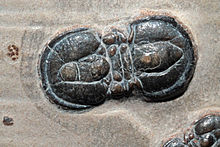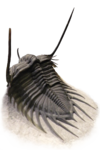Agnostida
| Agnostida Temporal range:
| |
|---|---|

| |
| Itagnostus interstrictus | |
| Scientific classification | |
| Domain: | Eukaryota |
| Kingdom: | Animalia |
| Phylum: | Arthropoda |
| (unranked): | †Artiopoda |
| Subphylum: | †Trilobitomorpha |
| Class: | †Trilobita(?) |
| Order: | †Agnostida Salter,1864 |
| Families | |
|
SuborderAgnostina
SuborderEodiscina | |
| Synonyms | |
|
Isopygia Gürich, 1907 | |
Agnostidaare anorderof extinctarthropodswhich have classically been seen as a group of highly modifiedtrilobites,though some recent research has doubted this placement. Regardless, they appear to be close relatives as part of theArtiopoda.[1]They are present in theLower Cambrianfossil record along withtrilobitesfrom theRedlichiida,Corynexochida,andPtychopariidaorders, and were highly diverse throughout theCambrian.Agnostidan diversity severely declined during the Cambrian-Ordoviciantransition, and the last agnostidans wentextinctin the Late Ordovician.[2]
Systematics
[edit]The Agnostida are divided into two suborders —AgnostinaandEodiscina— which are then subdivided into a number offamilies.As a group, agnostids are isopygous, meaning theirpygidiumis similar in size and shape to theircephalon.Most agnostid species were eyeless.
The systematic position of the order Agnostida within the class Trilobita remains uncertain, and there has been continuing debate whether they are trilobites or astem group.The challenge to the status has focused on Agnostina partly due to thejuvenilesof one genus have been found with legs differing dramatically from those of adult trilobites,[3]suggesting they are not members of thelamellipedianclade,of which trilobites are a part. Instead, the limbs of agnostids closely resemble those of stem group crustaceans, although they lack theproximal endite,which defines that group. The study suggested that they were likely thesister taxonto the crustacean stem lineage, and, as such, part of the clade,Crustaceomorpha.[4]Other researchers have suggested, based on acladisticanalyses ofdorsalexoskeletalfeatures, that Eodiscina and Agnostida are closely united, and the Eodiscina descended from the trilobite orderPtychopariida.[5]A 2019 study of adult specimens with preserved soft tissue from theBurgess Shalefound that agnostidans shared morphological similarities to trilobites and other relatedartiopodanslikenektaspids,and their placement as stem-crustaceans was unsupported. The study recovered agnostidans as the sister group to other trilobites within the Artiopoda.[1]
Ecology
[edit]Scientists have long debated whether the agnostids lived apelagicor abenthiclifestyle. Their lack of eyes, a morphology not well-suited for swimming, and their fossils found in association with other benthic trilobites suggest a benthic (bottom-dwelling) mode of life. They are likely to have lived on areas of the ocean floor which received little or no light and fed ondetrituswhich descended from upper layers of the sea to the bottom. Their wide geographic dispersion in thefossil recordis uncharacteristic of benthic animals, suggesting a pelagic existence. The thoracic segment appears to form a hinge between the head and pygidium allowing for a bivalvedostracodan-type lifestyle. The orientation of the thoracic appendages appears ill-suited for benthic living. Recent work suggests that some agnostids were benthic predators, engaging in cannibalism and possibly pack-hunting behavior.[6]
They are sometimes preserved within the voids of other organisms, for instance within emptyhyolithconchs,[7]withinsponges,worm tubesand under the carapaces ofbivalved arthropods,[8]presumably in order to hide from predators or strong storm currents; or maybe whilst scavenging for food.[8]In the case of the tapering worm tubesSelkirkia,trilobites are always found with their heads directed towards the opening of the tube, suggesting that they reversed in; the absence of any moulted carapaces suggests that moulting was not their primary reason for seeking shelter.[8]
References
[edit]- ^abMoysiuk J, Caron JB (January 2019)."Burgess Shale fossils shed light on the agnostid problem".Proceedings. Biological Sciences.286(1894): 20182314.doi:10.1098/rspb.2018.2314.PMC6367181.PMID30963877.
- ^Barnes BD, Sclafani JA, Zaffos A (April 2021)."Dead clades walking are a pervasive macroevolutionary pattern".Proceedings of the National Academy of Sciences of the United States of America.118(15).doi:10.1073/pnas.2019208118.PMC8053996.PMID33827921.S2CID233184869.
- ^Müller KJ, Walossek D (1987). "Morphology, ontogeny, and life habit ofAgnostus pisiformisfrom the Upper Cambrian of Sweden ".Fossils and Strata.19:1–124.doi:10.18261/8200075117-1987-01.ISBN8200075117.
- ^Bergström J, Hou XG (2005). "Early Palaeozoic non-lamellipedian arthropods". In Koenemann S, Ronald AJ (eds.).Crustacea and Arthropod Relationships.Taylor and Francis Group. pp. 75–93.ISBN978-1-4200-3754-8.
- ^Cotton TJ,Fortey RA(2005). "Comparative morphology and relationships of the Agnostida". In Koenemann S, Jenner RA (eds.).Crustacea and Arthropod Relationships.Vol. 16. Taylor and Francis Group. pp. 95–136.ISBN978-1-4200-3754-8.
- ^McMenamin MA (October 2010). "Cambrian cannibals: agnostid trilobite ethology and the earliest known case of arthropod cannibalism".Geological Society of America Abstracts with Programs.42(5): 320.
- ^Fatka O, Vokáč V, Moravec J, Šinágl M, Valent M (January 2009). "Agnostids entombed in hyolith conchs".Memoirs of the Association of Australasian Palaeontologists.37:481–489.
- ^abcChatterton BD, Collins DH, Ludvigsen R (2003)."Cryptic behaviour in trilobites: Cambrian and Silurian examples from Canada, and other related occurrences".In Lane PD, Siveter DJ,Fortey RA(eds.).Trilobites and Their Relatives.Special Papers in Palaeontology. Vol. 70.The Palaeontological Association.pp. 157–173.ISBN978-0-901702-81-4.
External links
[edit]- Order Agnostidaby Sam Gon III.
- The Virtual Fossil Museum – Trilobite Order Agnostida
- Agnostida fact sheetby Sam Gon III.
- "Earth's Early Cannibals Caught in the Act",by Larry O'Hanlon, news.discovery.

